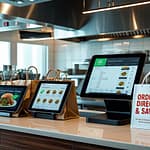Key Takeaways:
- Evaluate the cost-effectiveness of loyalty programs by measuring customer retention rates and increased spending.
- Invest in a rewards strategy that provides genuine value to customers, promoting repeat business.
- Regularly analyze and update loyalty programs to ensure they remain relevant and appealing to your customer base.
- Utilize loyalty programs to gather customer data, enabling personalized marketing and improved customer experience.
- Consider the impact of a loyalty program on your brand image, ensuring it aligns with your restaurant’s values and target audience.
Loyalty Programs: Smart Investment or Unnecessary Expense?
Explore whether loyalty programs truly pay off
In the highly competitive restaurant industry, attracting customers is often less challenging than retaining them. Restaurant owners constantly seek innovative strategies to encourage repeat visits, build lasting relationships, and foster brand loyalty. One popular solution is launching customer loyalty programs—but are these programs genuinely beneficial, or are they merely an unnecessary expense?
This article explores the effectiveness of loyalty programs, examining their impact on customer retention, overall profitability, and long-term growth. We’ll look at practical advice, successful industry examples, and how you can implement an effective rewards strategy at your restaurant.
Understanding Loyalty Programs in the Restaurant Industry
Loyalty programs are structured marketing strategies designed to encourage customers to continue patronizing a specific establishment. Typically, customers earn rewards such as discounts, free items, or exclusive offers based on their frequency of visits or amount spent.
Restaurants commonly use loyalty programs to:
- Increase customer retention rates
- Encourage higher spending per visit
- Collect valuable customer data and insights
- Differentiate their brand from competitors
Common Types of Loyalty Programs
Before deciding if a loyalty program suits your restaurant, it’s important to understand the various types available:
- Points-Based Programs: Customers accumulate points based on spending, redeemable for rewards.
- Tiered Programs: Customers unlock higher-value rewards as they advance through membership tiers.
- Punch Cards: Customers receive a reward after a specific number of visits or purchases.
- Subscription-Based Programs: Customers pay a recurring fee for exclusive perks and discounts.
The Pros and Cons of Restaurant Loyalty Programs
Advantages: How Loyalty Programs Help Your Business
When effectively implemented, loyalty programs offer considerable benefits, including:
- Enhanced Customer Retention: Rewarding customers for repeat visits encourages them to choose your restaurant over competitors.
- Increased Customer Spending: Customers enrolled in loyalty programs typically spend more per visit, driven by incentives and rewards.
- Improved Customer Data Collection: Capturing customer information allows you to personalize marketing and enhance guest experiences.
- Stronger Brand Engagement: Loyalty programs foster emotional connections and deeper relationships with customers, driving word-of-mouth referrals.
For example, Starbucks’ famously successful rewards program significantly boosted both customer retention and average spending per transaction. Members of the Starbucks Rewards program have demonstrated increased frequency of visits and higher overall spending.
Challenges: Potential Downsides of Loyalty Programs
Despite their benefits, loyalty programs can present challenges that restaurant owners must carefully consider:
- Cost and Complexity: Initial setup costs and ongoing management of loyalty programs can be expensive and resource-intensive.
- Data Management Issues: Handling and protecting customer data can be complicated and requires adherence to strict privacy regulations.
- Risk of Diluting Your Brand: Poorly implemented programs or overly generous incentives may diminish perceived brand value or profitability.
Without proper management, loyalty programs risk becoming financial liabilities instead of profit centers. For instance, a small independent restaurant might struggle with the administrative aspects of tracking rewards, leading to customer dissatisfaction and negative reviews.
Implementing a Successful Loyalty Program: Actionable Advice
If you decide that a loyalty program aligns with your restaurant’s goals, consider these practical steps to ensure the program maximizes return on investment:
1. Clearly Define Objectives and Metrics
Start by setting clear, measurable goals. Determine what you want to accomplish—whether increasing repeat visitation, capturing customer data, or boosting average spending per visit. Establish key performance indicators (KPIs) such as customer retention rates, frequency of visits, and average ticket size.
2. Choose the Right Type of Program
Select a loyalty program suited to your operational capabilities, budget, and customer base. For casual dining establishments with repeat customers, punch cards or digital points-based systems may work best. Upscale dining may benefit from tiered programs offering exclusive experiences.
3. Leverage Technology for Efficiency
Utilize user-friendly loyalty platforms or software that integrate seamlessly with your existing point-of-sale (POS) systems. Simplifying the process ensures smooth customer interactions and reduces the operational burden on your staff.
4. Keep Rewards Simple and Relevant
Offer compelling rewards that resonate with your customers. Rewards should feel achievable yet valuable enough to motivate repeat visits. Consider offering popular menu items, exclusive events, or personalized discounts based on customer preferences.
5. Regularly Communicate and Engage with Customers
Consistently remind customers of their rewards balances and upcoming incentives through targeted email marketing, social media updates, or personalized messages. Regular communication increases program participation and customer engagement.
6. Continuously Track, Analyze, and Optimize
Review loyalty program performance regularly. Analyze data to understand customer behavior, identify opportunities for improvement, and adjust your strategy accordingly. Tracking allows you to refine rewards, optimize ROI, and maintain customer interest.
Case Studies: Loyalty Programs Done Right
Panera Bread: Enhancing Customer Experience through Personalization
Panera Bread’s loyalty program, MyPanera, successfully leverages personalized rewards and targeted communications. By analyzing customer purchasing data, Panera offers highly relevant rewards, increasing customer visits and spending. The result? Higher customer retention and a more engaging guest experience.
Chipotle Rewards: Leveraging Digital Innovation
Chipotle’s digital-first loyalty program has been instrumental in driving growth. Through an intuitive mobile app, customers easily track rewards, customize orders, and receive personalized offers. This convenient digital experience has significantly increased customer engagement and repeat visits.
Conclusion: Are Loyalty Programs Worth It?
Ultimately, the success of a loyalty program depends on thoughtful planning, clear objectives, and diligent management. While loyalty programs can significantly boost customer retention, enhance guest experiences, and increase profitability, they require investment, ongoing monitoring, and optimization.
Restaurant owners and managers must carefully weigh the pros and cons, considering their unique business model, customer base, and resources. When executed properly, loyalty programs become powerful tools for driving long-term growth and cultivating lasting customer relationships.






Comments
Be the first to comment on this article.